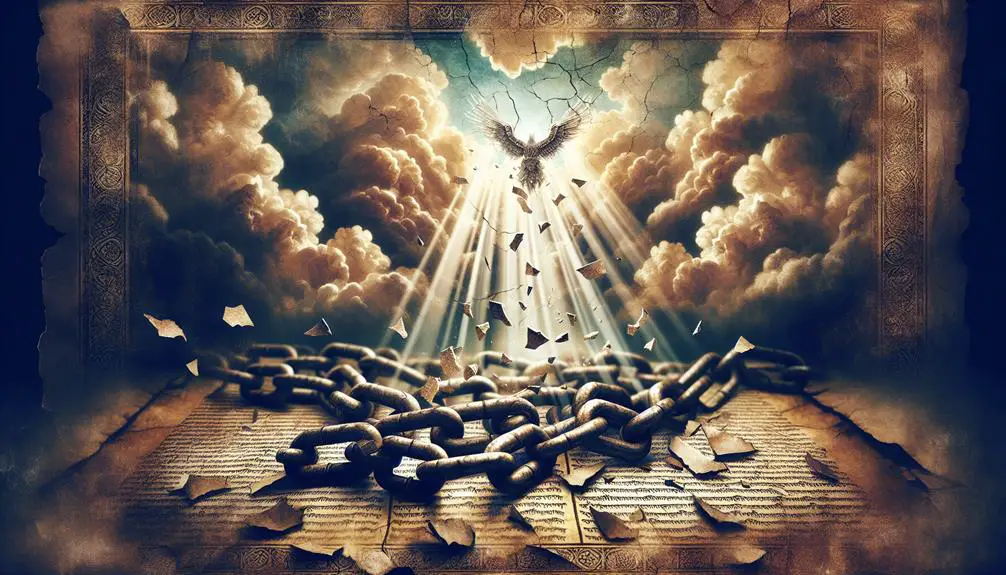Explore how fetters in the Bible symbolize more than just physical chains, hinting at deeper spiritual struggles and redemption.

Fetters in the Bible
In the tapestry of biblical narratives, fetters aren't just chains; they symbolize the weight of spiritual and physical bondage that characters endure. You'll find that these iron links serve not only as a tool for imprisonment but also as a metaphor for the struggles against sin and oppression.
As you explore the historical context and notable references within the Scriptures, you'll uncover how these stories of confinement and subsequent liberation resonate through the ages. The journey through these passages might just offer you a fresh perspective on the chains that bind us today and the keys to unlocking them.
Key Takeaways
- Fetters symbolize both physical and spiritual bondage in biblical narratives, underscoring human struggles.
- They were made of iron or bronze, indicating the strength and permanency of constraints.
- Biblical references use fetters to depict themes of power, submission, and divine order versus chaos.
- Modern interpretations view fetters as metaphors for fighting against societal injustice and spiritual oppression.
Symbolism of Fetters

Exploring the symbolism of fetters in the Bible reveals their multifaceted role as instruments of oppression and metaphors for spiritual bondage. The material composition and crafting techniques of fetters, often detailed in biblical texts, further enrich their symbolic resonance. Typically made of iron or bronze, these materials themselves carry connotations of strength and permanence, suggesting the formidable nature of the bonds they represent. The process of crafting these fetters, involving forging and shaping under intense heat, can be seen as an allegory for the trials and tribulations that shape human spirit and faith.
Moreover, the Bible frequently employs fetters as symbols to illustrate the constraining power of sin and the struggle against spiritual captivity. For instance, Psalm 107:10-16 speaks of those 'bound in affliction and iron,' underscoring the theme of liberation from the fetters of darkness through divine intervention. This imagery not only highlights the physical attributes and creation of fetters but also delves into their deeper spiritual significance, offering insights into the human condition and the path to redemption. Through this lens, fetters in the Bible transcend their literal function, embodying the profound struggles and ultimate hope of faith.
Historical Context

Understanding the symbolism of fetters in the Bible enriches when we consider their historical context, revealing not just spiritual implications but also tangible realities of the ancient world. The material composition and manufacturing methods of fetters provide insight into the technological capabilities and social structures of ancient civilizations.
- Material Composition: Fetters in biblical times were primarily made of iron, though bronze was also used. The choice of material was influenced by its availability and the technological level of the society. Iron, being stronger and more durable, was preferred for its ability to securely detain prisoners.
- Manufacturing Methods: The process of making fetters involved forging and smithing, skills that were highly regarded. Artisans heated the metal to high temperatures before shaping it, a technique that required considerable skill and knowledge.
- Economic Implications: The production of fetters also reflected the economic conditions of the time. The resources and labor required to produce these restraints indicated the value placed on controlling and punishing wrongdoers.
- Social and Political Context: The use of fetters was a tangible expression of power and authority. Their application served as a deterrent and a method of control, reinforcing the social hierarchy and the rule of law.
Notable Biblical References

Diving into the biblical text, we find numerous instances where fetters symbolize not only physical bondage but also deeper spiritual and moral themes. The imagery of 'Fettered Giants' in scripture isn't just literal chains on formidable foes; it's a metaphor for the suppression of powerful forces of chaos and evil by divine authority. This concept, while not always directly referenced, underpins stories where God's intervention restrains evil, showcasing a battle between divine order and chaos.
Similarly, the 'Prophet's Chains' evoke a rich tapestry of meanings beyond physical imprisonment. These chains represent the struggle and persecution faced by prophets as they deliver God's messages. The prophet Jeremiah, for instance, wore a yoke as a symbol of bondage and submission to God's will, illustrating how fetters can also signify an individual's commitment to divine truth despite personal suffering.
Through these references, the Bible uses the motif of fetters to explore themes of power, submission, and the human condition in the face of divine mandate. These symbols aren't merely historical artifacts but are woven into the fabric of biblical narrative to express complex theological ideas.
Lessons on Liberation

In the biblical narrative, references to liberation often serve as pivotal moments where individuals or groups are freed from physical, spiritual, or societal fetters, illustrating profound theological insights into the nature of freedom and divine deliverance. This liberation isn't just a historical or narrative device; it's a framework through which you can understand your journey toward personal growth and spiritual freedom.
Here are four key lessons you can draw from these biblical instances of liberation:
- Self-Reflection Leads to Liberation: The process of self-examination can free you from the internal chains that hinder your growth. Biblical stories underscore the importance of introspection in achieving spiritual freedom.
- Divine Intervention is a Catalyst for Change: Many narratives highlight how liberation often comes through divine intervention, signaling that spiritual freedom is sometimes beyond human capability alone.
- Community is Instrumental: The liberation of individuals often leads to or requires the support of a community. This interconnectedness illustrates the power of collective action in overcoming societal fetters.
- Freedom Comes with Responsibility: Once freed, individuals in the Bible are tasked with living in a way that honors their liberation. This mirrors the idea that personal and spiritual freedom should guide one's actions towards righteousness and service.
These lessons emphasize the multifaceted approach to liberation encompassing personal, spiritual, and communal aspects, guiding you toward a more profound understanding of freedom.
Modern Interpretations

As we examine modern interpretations of biblical liberation, it's crucial to recognize how contemporary scholars and theologians have recontextualized these ancient narratives within today's socio-political and spiritual landscapes. The influence of cultural shifts on scriptural interpretation can't be overstated. These shifts have ushered in a period marked by interpretive diversity, enabling a broader, more inclusive understanding of biblical texts.
You'll find that modern theologians, such as Walter Brueggemann and Elizabeth Schüssler Fiorenza, advocate for readings that emphasize liberation and justice, reflecting current concerns over inequality and oppression. This approach contrasts with earlier interpretations that often overlooked these themes in favor of maintaining the status quo.
Moreover, the advent of liberation theology in the late 20th century, particularly in Latin America, has highlighted the Bible's potential as a tool for social change. This movement interprets biblical narratives as calls to action against injustice, aligning ancient teachings with contemporary struggles for equity and freedom.
In essence, today's interpretive diversity reflects an ongoing dialogue between the sacred text and the lived experiences of communities. It's a testament to the Bible's enduring relevance and its capacity to inspire hope and transformation in the face of modern challenges.
Frequently Asked Questions
How Have Different Translations of the Bible Influenced the Understanding and Depiction of Fetters?
Different translations have shaped your understanding of certain concepts, notably through their accuracy and the cultural context they provide.
When you delve into translations, you're exploring how shifts in language and interpretive frameworks can significantly alter the depiction of ideas.
In this case, the portrayal of constraints or limitations has varied, demonstrating how linguistic nuances and historical perspectives influence your grasp of textual elements, thereby enriching or limiting the comprehension of underlying themes.
Are There Any Archaeological Findings That Directly Relate to the Types of Fetters Mentioned in the Bible?
Yes, archaeologists have unearthed artifacts that mirror the fetter materials described in ancient texts. Imagine the chill of iron against skin, the weight that drags footsteps into a shuffle.
These findings, often resembling modern handcuffs or leg irons, provide a tangible connection to past restraints. Scholars analyze these relics, comparing them to historical accounts to deepen our understanding of ancient confinement methods and their evolution into today's analogues.
How Do Other Ancient Texts Outside of the Bible, Such as Those From Mesopotamia or Egypt, Depict or Discuss the Use of Fetters?
Ancient texts from Mesopotamia and Egypt offer insights into how fetters symbolized control and punishment. These documents reveal that fetter usage was widespread, reflecting societal norms around captivity and restraint.
What Are the Psychological Implications of Fetter Imagery in Biblical Narratives on Contemporary Readers or Believers?
You might wonder how imagery of restraint or confinement impacts you today. Modern therapy implications suggest that such imagery, when analyzed, can help develop your emotional resilience.
How Have Depictions of Fetters in Biblical Stories Been Represented in Religious Art Throughout History?
When exploring how fetters have been depicted in religious art through history, you'll notice artists often exercise artistic freedom, interpreting these images in diverse ways.
Modern interpretations vary widely, reflecting changes in societal values and artistic trends. Scholars analyze these depictions to understand their impact on viewers and their faith.
Artistic representations of fetters have evolved, offering insights into historical and contemporary religious beliefs and practices.
Conclusion
As you've journeyed through the symbolism and historical depths of fetters in the Bible, it becomes clear that these chains aren't merely iron bindings, but emblematic of spiritual and emotional captivity. Drawing parallels to the Exodus, one can't help but see the echoes of liberation that resonate throughout scripture (Exodus 6:6).
This exploration, rich in scholarly analysis, underscores the perennial quest for freedom, reminding us that breaking our contemporary fetters is both a personal and collective exodus, ever relevant in our modern interpretation.



Sign up